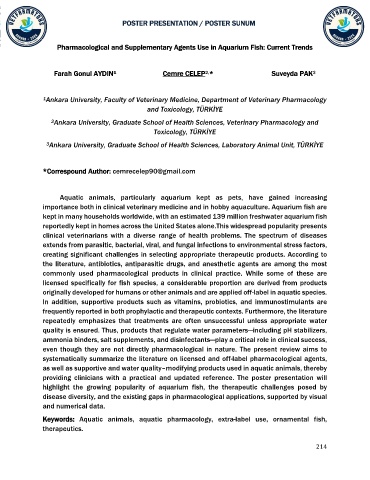Page 217 - congress
P. 217
POSTER PRESENTATION / POSTER SUNUM
Pharmacological and Supplementary Agents Use in Aquarium Fish: Current Trends
Farah Gonul AYDIN¹ Cemre CELEP * Suveyda PAK
2,
3
¹Ankara University, Faculty of Veterinary Medicine, Department of Veterinary Pharmacology
and Toxicology, TÜRKİYE
2 Ankara University, Graduate School of Health Sciences, Veterinary Pharmacology and
Toxicology, TÜRKİYE
3 Ankara University, Graduate School of Health Sciences, Laboratory Animal Unit, TÜRKİYE
*Correspound Author: cemrecelep90@gmail.com
Aquatic animals, particularly aquarium kept as pets, have gained increasing
importance both in clinical veterinary medicine and in hobby aquaculture. Aquarium fish are
kept in many households worldwide, with an estimated 139 million freshwater aquarium fish
reportedly kept in homes across the United States alone.This widespread popularity presents
clinical veterinarians with a diverse range of health problems. The spectrum of diseases
extends from parasitic, bacterial, viral, and fungal infections to environmental stress factors,
creating significant challenges in selecting appropriate therapeutic products. According to
the literature, antibiotics, antiparasitic drugs, and anesthetic agents are among the most
commonly used pharmacological products in clinical practice. While some of these are
licensed specifically for fish species, a considerable proportion are derived from products
originally developed for humans or other animals and are applied off-label in aquatic species.
In addition, supportive products such as vitamins, probiotics, and immunostimulants are
frequently reported in both prophylactic and therapeutic contexts. Furthermore, the literature
repeatedly emphasizes that treatments are often unsuccessful unless appropriate water
quality is ensured. Thus, products that regulate water parameters—including pH stabilizers,
ammonia binders, salt supplements, and disinfectants—play a critical role in clinical success,
even though they are not directly pharmacological in nature. The present review aims to
systematically summarize the literature on licensed and off-label pharmacological agents,
as well as supportive and water quality–modifying products used in aquatic animals, thereby
providing clinicians with a practical and updated reference. The poster presentation will
highlight the growing popularity of aquarium fish, the therapeutic challenges posed by
disease diversity, and the existing gaps in pharmacological applications, supported by visual
and numerical data.
Keywords: Aquatic animals, aquatic pharmacology, extra-label use, ornamental fish,
therapeutics.
214

